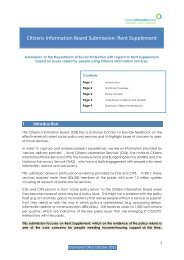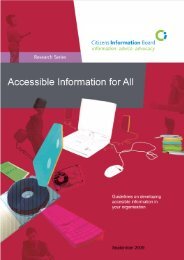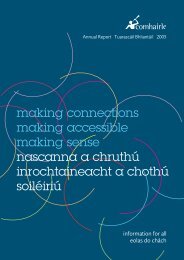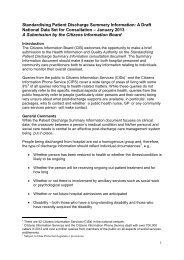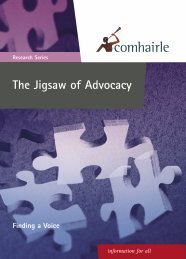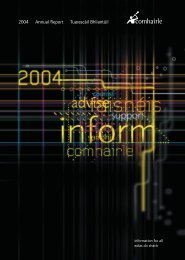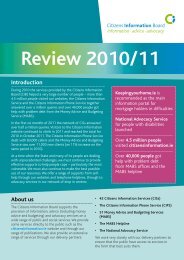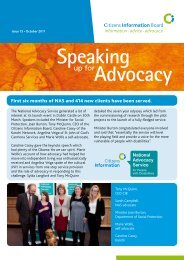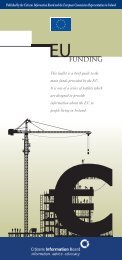Review of Sign Language Interpretation Services and Service ...
Review of Sign Language Interpretation Services and Service ...
Review of Sign Language Interpretation Services and Service ...
- No tags were found...
Create successful ePaper yourself
Turn your PDF publications into a flip-book with our unique Google optimized e-Paper software.
were absence <strong>of</strong> provision for a management structure within Irish <strong>Sign</strong> Link,inadequate funding for the administrative staffing, weak governance <strong>and</strong> anunduly politicised Board. Financial management practice was regarded by somecontributors as having been poor, resulting in difficulties for the organisation.Interpreters experienced a number <strong>of</strong> periods when they were not paid. Many<strong>of</strong> these difficulties were seen by several contributors as directly linked to the lack<strong>of</strong> consistent <strong>and</strong> committed state support for the organisation.Bottlenecks in accreditation, <strong>and</strong> problems <strong>of</strong> uneven distribution <strong>of</strong> interpreterswere sometimes seen as the responsibility <strong>of</strong> Irish <strong>Sign</strong> Link; however, manyacknowledged that these problems were embedded in the way provision hasevolved, <strong>and</strong> were not necessarily, or even appropriately, the responsibility <strong>of</strong>that organisation.4.10.2 Delivery systemsThere were differing views about the most appropriate model for delivering signlanguage interpretation services. One view was that, once st<strong>and</strong>ards are in place<strong>and</strong> dem<strong>and</strong> <strong>and</strong> supply are projected, market forces should do the rest, withminimum state intervention. An alternative view was that a market model <strong>and</strong> acompletely privatised service will not work, <strong>and</strong> will result in a fragmented <strong>and</strong>piecemeal service. Another view was that Irish <strong>Sign</strong> Link should be capable <strong>of</strong>developing into a commercially viable organisation, where the fees collected frompublic <strong>and</strong> private customers finance the running costs <strong>of</strong> the organisation. Theimportance <strong>of</strong> competition <strong>and</strong> competitive prices was raised.Some felt that a mix <strong>of</strong> self employed <strong>and</strong> employed sign language interpreterswill be needed in order to overcome some <strong>of</strong> the structural problems inherent in afully freelance service. The option <strong>of</strong> training staff in public sector organisations tointerpret was raised, but problems with this approach were also identified (such asthe difficulty for staff in managing this task alongside their core work, <strong>and</strong> thedifficulty in maintaining the level <strong>of</strong> skill needed).In terms <strong>of</strong> the future <strong>of</strong> Irish <strong>Sign</strong> Link, that organisation <strong>and</strong> representative bodiesin particular felt that it should play an important role in the future, with appropriateState financial support. Among the suggestions made for improving its capacity werestrengthened managerial capacity through the appointment <strong>of</strong> a CEO, improvedadministrative capacity, regionalisation, strong financial management, restructuring <strong>of</strong>the governance <strong>of</strong> Irish <strong>Sign</strong> Link, involving additional skills on the Board, widerrepresentation <strong>and</strong> a less closed Board structure, <strong>and</strong> a strategic <strong>and</strong> operational planwith clear goals <strong>and</strong> timeframes for action.There was a suggestion that Irish <strong>Sign</strong> Link should be independent <strong>of</strong> both theIrish Deaf Society <strong>and</strong> National Association for Deaf People, while another viewwas that both these organisations should be involved, <strong>and</strong> on an equal basis. Yetanother view was that, if the State does not provide the kind <strong>of</strong> infrastructuralsupport needed, <strong>and</strong> a home for the organisation, it should be placed under theauspices <strong>of</strong> a parent organisation within the community <strong>and</strong> voluntary sector,rather than be 'left alone'.<strong>Review</strong> <strong>of</strong> <strong>Sign</strong> <strong>Language</strong> <strong>Interpretation</strong> <strong><strong>Service</strong>s</strong> <strong>and</strong> <strong>Service</strong> Requirements in Irel<strong>and</strong> • page 77



